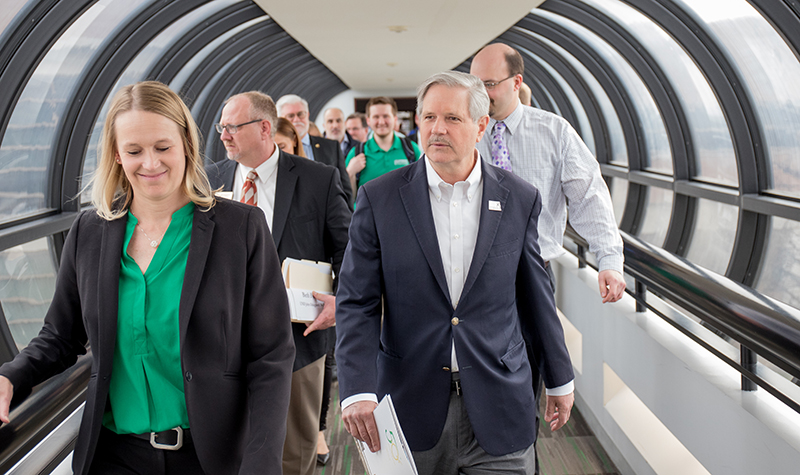UND lauds congressional stamp of approval on air traffic controller hiring reform

Thanks in part to the leadership of U.S. Sen. John Hoeven, R-N.D., the Air Traffic Controller Hiring Reform Act has passed through its inclusion in the National Defense Authorization Act for Fiscal Year 2020. Congress passed the Authorization Act on a bipartisan basis earlier this week.
UND would like to thank Sen. Hoeven for his strong advocacy and support of the hiring reform, which promises to significantly raise the value to students, North Dakota and the nation of a UND Air Traffic Management degree.
Earlier this year, Hoeven and U.S. Sen. Jeanne Shaheen, D-N.H., introduced the legislation to help improve the Federal Aviation Administration’s hiring process for air traffic controllers. The bill ensures the agency can prioritize the hiring of veterans and graduates of FAA Certified Collegiate Training Initiative (CTI) schools.
UND is a leader among 31 such CTI institutions nationwide.
“The Air Traffic Controller Hiring Reform Act is important for UND Aerospace and its ATC graduates,” Hoeven said.
“The University of North Dakota is a premier aviation and aerospace university, and one of the FAA’s certified training institutions (CTIs). Given our nation’s shortage of air traffic controllers, it only makes sense that the FAA hire graduates of UND and other CTI schools, as well as veterans, to help meet our nation’s needs.
“This legislation reforms the FAA’s hiring process to ensure and ensures FAA can hire the most qualified candidates.”
Two pools

Under the old law, the FAA was required to hire air traffic controllers from two pools of candidates. The first pool included eligible veterans as well as graduates of CTI schools, including UND and Southern New Hampshire University. The second pool consisted of individuals applying under vacancy announcements or “off the street” hires.
Also under the old law, the FAA had to hire about the same number of candidates from the two pools. No more than a 10 percent difference in the number of hires between the pools was allowed by the policy.
Hoeven and Shaheen’s legislation seeks to ensure the most qualified individuals are entering the air traffic control workforce. The bill does this by giving hiring preference to graduates of CTI schools and veterans and removing the 10 percent limitation between hiring pools.
In addition, the legislation also requires the FAA to regularly report to Congress on new hire performance and attrition rates. Previously, data was not available to determine each pools’ effectiveness after being hired and sent to ATC qualification training at the FAA Academy in Oklahoma City.
“The University of North Dakota (UND) was one of the first FAA approved Air Traffic – Collegiate Training Initiative (AT-CTI) schools in the nation with a history of continuously striving for excellence,” said Dr. Joshua Wynne, Interim President of the University of North Dakota.
“The passage of the ATC Hiring Reform Act will ensure the highest quality of aviation professional, like those graduating from UND, will be hired to manage our increasingly complex airspace. We greatly appreciate Sen. Hoeven’s ongoing leadership and support on this important issue, which will help ensure that the skies are controlled safely.”
Enrollment drop
Elizabeth Bjerke, associate dean of the John D. Odegard School of Aerospace Sciences, also thanked Hoeven for his diligence in passing the legislation. Ever since the more-restrictive ATC hiring policy took effect five years ago, the faculty and staff of UND Aerospace have been in close contact with Hoeven, Bjerke said.
By making a UND Air Traffic Management degree a less-valuable credential in the FAA’s eyes, the more-restrictive policy had caused a sharp drop in enrollment in the degree program.
“Not only does Sen. Hoeven reach out to understand our concerns, he brings key individuals from Washington to campus for face-to-face discussions with our faculty, staff and students,” Bjerke said. “This level of interaction is truly amazing and has fostered positive change, not only for UND and North Dakota, but also for the entire aviation ecosystem. We are grateful to have Hoeven’s strong support.”
The University of North Dakota offers one of the most advanced air traffic control training facilities found anywhere, said Paul Drechsel, associate professor and assistant chair of UND’s air traffic management program. Drechsel and fellow faculty are now confident that aspiring air traffic controllers will once again recognize the value of a four-year education that creates well-rounded aviation professionals.
Graduates of UND’s air traffic management curriculum, given their extensive, hands-on simulator experience, can bypass the Air Traffic Basics Course, which is the first five weeks of FAA Academy training.
The University’s ATC simulation laboratories feature two virtual control towers — with 225-degrees and 360-degrees of visibility, respectively — with 12 integrated radar positions between them, as well as 32 state-of-the-art, en-route radar simulators. The capacity ensures the University’s ability to meet FAA demands in training and expertise, Drechsel said.
“With this simulation system, the students can experience the teamwork of safely controlling aircraft from the en-route environment, through the approach control, to a landing with the control tower,” he said. “Other features are an instructor’s station to control and monitor training, four student stations, three pseudo-pilot stations and a scenario and image modeling workstation.
“In addition to these excellent facilities, UND Aerospace faculty members have outstanding credentials and are widely recognized for their innovative contributions in curriculum development, air traffic control training, instructional technology and research.”


